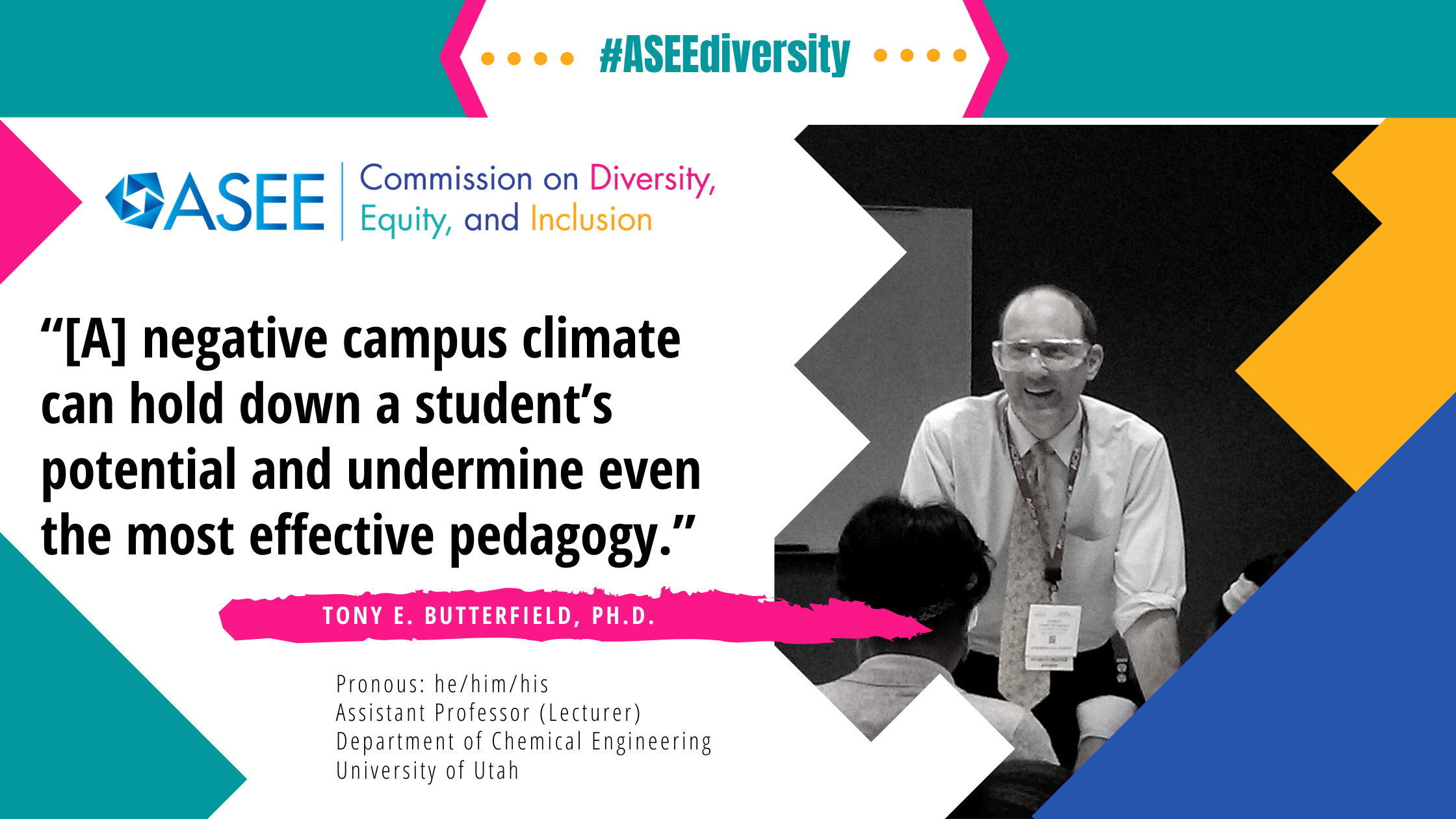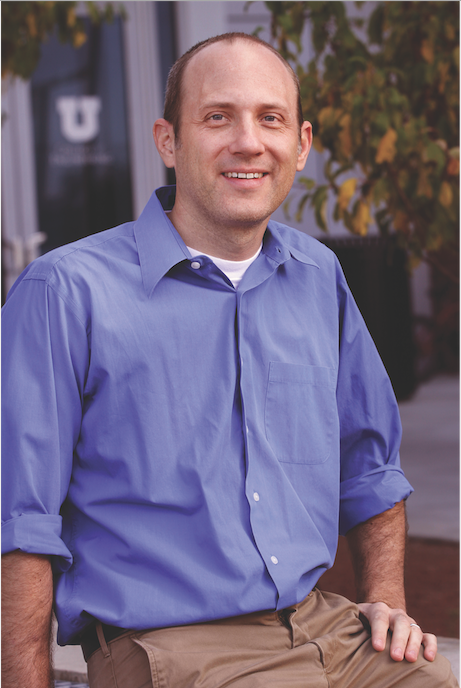
ASEE CDEI Scholar Spotlight Series: Dr. Tony E. Butterfield

Dr. Tony E. Butterfield: Empowering faculty and students to create an inclusive environment for the LGBTQ+ community
It is an honor to share Tony’s story, mainly because, for me, he is one of the leading voices in chemical engineering for the LGTBQ+ community and outreach efforts in his professional organizations, ASEE and AIChE. His research in engineering education focuses on creating meaningful project-based learning experiences for first-year engineering students and K-12 outreach. He also has an open-access project to provide instructors with resources to teach chemical engineering topics in an online environment. Besides his many honors and roles, he mentioned that his marriage to his husband Paul and their twins William and Lucas are his most significant accomplishment.
Enjoy learning about Tony’s story, current work, insights, and future plans on Diversity, Equity, and Inclusion (DEI). At the end of this post, don’t miss out on the opportunity to connect with our scholar and learn more about the ASEE CDEI‘s efforts.
ASEE CDEI Communications Committee Volunteers:
- Introduction and editor: Sindia M. Rivera-Jiménez, Ph.D., University of Florida (Twitter)
- Volunteer Webmaster: Lulu Sun, Embry-Riddle Aeronautical University
Scholar Interview
Q: Can you tell us your story of belongingness?

Pronouns: He/They Assistant Professor (Lecturer) Department of Chemical Engineering University of Utah
As an engineering undergraduate, I quickly learned that I, as a gay man, was regarded by my peers and professors as completely out of place. I had faculty who told gay jokes in class, team members who would only work with me while wearing gloves, and each walk from one campus building to another carried a risk of being called some terrible names. In my first week in an engineering workplace, my boss gave me his unsolicited and cruel opinion on gay men when “warning” me that I would have to attend diversity training. I had been out of the closet since I was 15, but, to keep that first job, I’m ashamed to say each day I arrived at work I went back into the closet; I eventually left that job for the stress of it. My next engineering workplace wasn’t much better and so I decided to go into graduate school, hoping for a better workplace climate once some time had passed and I had accumulated additional credentials.
Happily, that plan worked out. My Ph.D. advisor was supportive, and I began to see a change in our profession at large. Topics of diversity and inclusion in engineering were not only becoming more prevalent, but they were also beginning to consider people from the LGBTQ+ community as part of “inclusion.” By the time I was able to take a faculty position, almost every university included LGBTQ+ individuals in their diversity statements.
But I still felt like an outsider in my profession, unable to trust coworkers. A true sea change came about, at least for me, with the creation of Dr. Stephanie Farrell’s virtual community of practice; this group focused on LGBTQ+ issues in engineering and developed a support network of wonderful allies across the country. The email inviting me to that group was the first time I had ever seen myself, as a gay man, invited into an engineering community, and since then a lot of great changes have happened. As part of this group I have conducted Safe Zone Training for faculty at many conferences across the country, I have helped begin a LGBTQ+ initiative for my professional organization, and I have been empowered to discuss topics of inclusion as integral to engineering ethics with my students and colleagues. Much more work is to be done, but I’m glad to say I work in a far better climate for LGBTQ+ engineers than I did as a frightened undergraduate.
Q: What is your understanding of DEI and why it is important to what you do?
As a professor, aiming for diversity means working to assure the people in the small sample of our classrooms and laboratories represent humanity. Inclusion, in my work, means that all those people we invite into our department feel welcome into the physical spaces and the culture of our department; they are valued for both what we share and for the unique histories and perspectives we bring to our teams. Equality in the classroom, to me, means ensuring everyone is given a fair shot. It takes work, care, and diligence to assure each student’s background is considered in giving a truly fair chance, and that the paths to success in the classroom truly measure a student’s talents and not the bias of the prevailing culture.
I know, directly, that a negative campus climate can hold down a student’s potential, and undermine even the most effective pedagogy. As such, to do my job properly I must first build and nurture a healthy, welcoming, and friendly foundation. We must certainly produce technically formidable professionals, but our students can also do great professional and personal harm to themselves and others through workplace hostility, bias (conscious or unconscious), and harassment. My teaching should address those topics both when they intersect with the technical content and as topics deserving of their own class periods, if I am to truly prepare our students for a productive and ethical career.
Q: What do you see as the next steps for your DEI work?
As faculty, I have developed DEI training to be included as lectures during the engineering ethics segments for both our first year and our senior students. I manage our department’s k-12 outreach team, which focuses on attracting and welcoming underrepresented students into our department. I also advise our oSTEM student group. I am also a member of the Societal Impact Operating Council of AIChE, helping my professional organization with DEI initiatives, such as diversity programming at conferences.
For my future steps, I would like to spread what I’ve found to be successful in my department to other departments in my college and across the country, by developing materials that would lower the activation energy for other faculty to include DEI content in their departments.
Q: What recommendations do you have for engineering educators to start incorporating social justice topics in their classrooms?
As with any engineering topic, to hold their interest, it is vital to first get the students’ buy-in on the usefulness of the topic. I believe it’s very valuable to make it clear that these topics are not separate from engineering topics. Almost all of the companies they will work for have personnel policies that, if violated, will be as serious as any technical error; I show them those policies and diversity statements. To be a successful engineer, they simply must be an inclusive engineer. To solve human problems, which is the key aim of engineering, they must consider all humans.
Working in a conservative culture, I also find it valuable to address the skepticism in the room directly. In this way, DEI topics are different from another engineering curriculum. Not many students approach, say, their heat transfer course with passionately held contrary opinions. Some students believe that DEI issues are not a problem “these days” and without showing you have at least heard their arguments, they often actively resist your instruction. I also tend to include a real-life case study, in my collection of case studies given to students. I try to put students in a mindset receptive to DEI instruction by including a real-life case study. These case studies focus on the dominant culture at our university and how to face discrimination when working out of state.
“[A] negative campus climate can hold down a student’s potential and undermine even the most effective pedagogy.”
Q: What is one resource that you can recommend to people who want to learn more about DEI in your field?
I have learned a great deal from my colleagues by attending DEI-related programming at conferences. At every conference, there are those times in which you are looking for a session; in those times I look for topics of diversity. Because DEI topics are all about the human experience, even a topic you have seen covered before, if covered by a different person, can give you new insights to bring back to your students and colleagues.
But above that, I would say our students are our greatest source of information about the climate in our profession. By letting them know you are a professor who truly cares about DEI topics and consequences, they will often come to you with their concerns and experiences. Their experiences have often disabused me of assumptions about how far we’ve come as a profession.

Dr. Butterfield conducting outreach activities at AIChE’s annual conference.
Recommended ASEE PEER paper from our scholar:
Branch, K. J., & Butterfield, A. (2016, June), Implementation and Usage of an Online Environment in a Chemical Engineering Curriculum Paper presented at 2016 ASEE Annual Conference & Exposition, New Orleans, Louisiana. 10.18260/p.25570
For many engineering professors, transferring our courses to an online environment was not an easy task. However, it is good to find resources online that we can use to implement in our classroom quickly. What I like about this paper is that it provides student activities, homework, and assessment in a way that can be easily used in the classroom. The best part of it is that all the resources are open access and accessible through the website vSTEM.org. I invite you to get inspired and maybe produce something similar within your own engineering field.
Connect with our scholar:
- Website(s): Professional Site, vSTEM Project, LGTBTQ+ Advocacy in STEM
- Connect in social media: Instagram
- Find articles on ASEE Peer: Butterfield
Getting involved with CDEI
- If you want to recommend someone for our Spotlight series click here.
- Check out website Highlights:
- Resources
- Past Blogs and Events
- Compilation of Newsletters and Reports
- Connect with the committee:
- Become a Friend of the Committee
- Follow us and tag us on Twitter
- Become a volunteer on our Communications Committee! We are always looking for people that want to share or improve their writing and leadership skills.
Check out other Spotlight Scholars:

